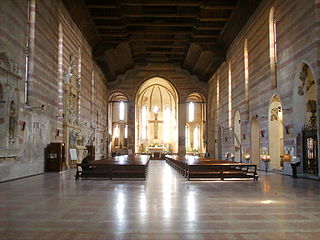
Church of the Eremitani
Encyclopedia


Padua
Padua is a city and comune in the Veneto, northern Italy. It is the capital of the province of Padua and the economic and communications hub of the area. Padua's population is 212,500 . The city is sometimes included, with Venice and Treviso, in the Padua-Treviso-Venice Metropolitan Area, having...
, northern Italy
Italy
Italy , officially the Italian Republic languages]] under the European Charter for Regional or Minority Languages. In each of these, Italy's official name is as follows:;;;;;;;;), is a unitary parliamentary republic in South-Central Europe. To the north it borders France, Switzerland, Austria and...
.
It was built in 1276 and dedicated to the saints Philip
Philip the Apostle
Philip the Apostle was one of the Twelve Apostles of Jesus. Later Christian traditions describe Philip as the apostle who preached in Greece, Syria, and Phrygia....
and James
James the Just
James , first Bishop of Jerusalem, who died in 62 AD, was an important figure in Early Christianity...
; it is however best known as degli Eremitani from the annexed old monastery
Monastery
Monastery denotes the building, or complex of buildings, that houses a room reserved for prayer as well as the domestic quarters and workplace of monastics, whether monks or nuns, and whether living in community or alone .Monasteries may vary greatly in size – a small dwelling accommodating only...
, which now houses the municipal art gallery.
The chapel
Chapel
A chapel is a building used by Christians as a place of fellowship and worship. It may be part of a larger structure or complex, such as a church, college, hospital, palace, prison or funeral home, located on board a military or commercial ship, or it may be an entirely free-standing building,...
of SS. James and Christopher
Saint Christopher
.Saint Christopher is a saint venerated by Roman Catholics and Orthodox Christians, listed as a martyr killed in the reign of the 3rd century Roman Emperor Decius or alternatively under the Roman Emperor Maximinus II Dacian...
(Ovetari Chapel
Ovetari Chapel
The Ovetari Chapel is a chapel in the right arm of the Church of the Eremitani in Padua. It is renowned for a Renaissance fresco cycle by Andrea Mantegna and others, painted from 1448 to 1457. The cycle was destroyed by an Allied bombing in 1944: today, only two scenes and a few fragments survive,...
), formerly illustrated by Mantegna
Andrea Mantegna
Andrea Mantegna was an Italian painter, a student of Roman archeology, and son in law of Jacopo Bellini. Like other artists of the time, Mantegna experimented with perspective, e.g., by lowering the horizon in order to create a sense of greater monumentality...
's fresco
Fresco
Fresco is any of several related mural painting types, executed on plaster on walls or ceilings. The word fresco comes from the Greek word affresca which derives from the Latin word for "fresh". Frescoes first developed in the ancient world and continued to be popular through the Renaissance...
es, was largely destroyed by the Allies
Allies of World War II
The Allies of World War II were the countries that opposed the Axis powers during the Second World War . Former Axis states contributing to the Allied victory are not considered Allied states...
in World War II
World War II
World War II, or the Second World War , was a global conflict lasting from 1939 to 1945, involving most of the world's nations—including all of the great powers—eventually forming two opposing military alliances: the Allies and the Axis...
, because it was next to a German
History of Germany during World War II
The history of Germany during World War II closely parallels that of Nazi Germany under Adolf Hitler. He came to power in Germany in 1933. From that point onward, Germany followed a policy of rearmament and confrontation with other countries...
headquarters. Other artists whose frescoes are preserved in the church include Guariento
Guariento
Guariento , sometimes incorrectly named Guerriero, was the first Paduan painter of distinction.The only date distinctly known in his career is 1355, when, having already acquired high renown in his native city, he was invited by the Venetian authorities to paint a Paradise, and some incidents of...
and Ansuino da Forlì
Ansuino da Forlì
Ansuino da Forlì was an Italian painter of the Quattrocento period. Born and active in Forlì and Padua in the mid-15th century, he was a member of a Forlì painting school and influed the great Melozzo da Forlì....
.
The church contains the tombs of Jacopo
Jacopo da Carrara
Jacopo or Giacomo da Carrara may refer to:*Jacopino da Carrara*Jacopo I da Carrara, , called the Great, founder Carraresi dynasty that ruled Padua from 1318 to 1405...
(1324) and Ubertinello (1345) da Carrara, lords of Padua.

